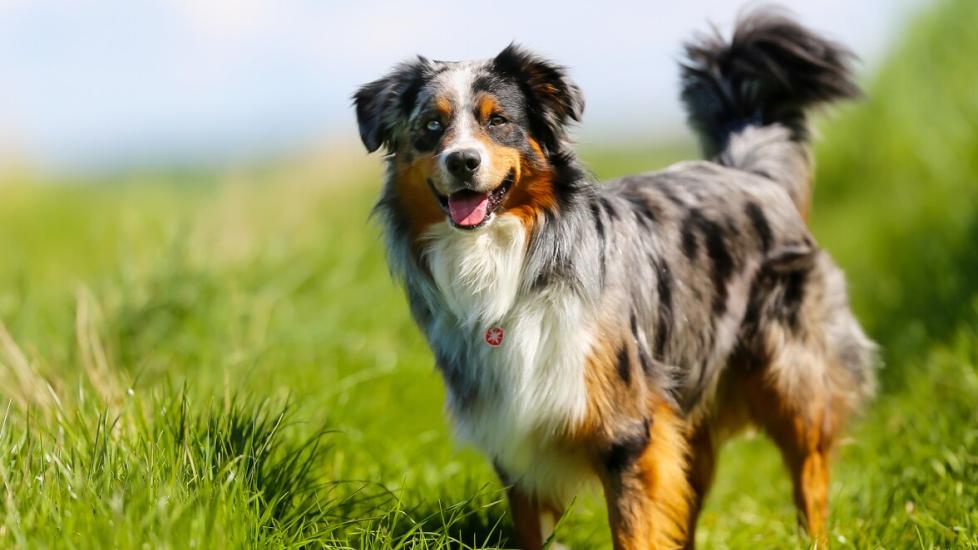Australian Shepherd
iStock/Bigandt_Photography
Australian Shepherds are highly intelligent and active medium-sized dogs with natural herding instincts and muscular and agile builds. They were originally bred to be used as working dogs and still have a strong drive to get jobs done and please their people.
Standing between 18–24 inches tall, the average Australian Shepherd weight is 40–65 pounds when full-grown, with males being generally larger than females.
Australian Shepherd tails can be naturally bobbed, or they can be born with full-length tails. Most Aussie puppies have their tails docked at a young age, though this practice is controversial. While tail docking can be done to prevent working dogs from tail-related injuries, the American Veterinary Medical Association (AMVA) opposes docking for purely cosmetic reasons.
Caring for an Australian Shepherd
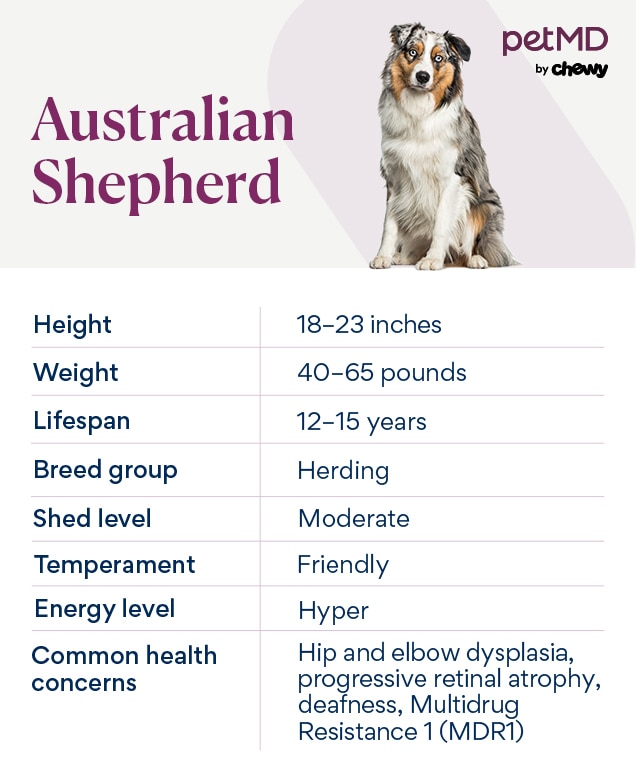
Australian Shepherds are high-energy dogs that love to have a job. They are known to be smart and loyal dogs that are typically friendly but can sometimes take a bit of time to warm up to strangers.
Due to their herding background, Australian Shepherds can have a prey drive and love games like fetch and Frisbee. But they might also like to chase moving objects—such as children, cats, cars, and other wheeled objects like scooters, bikes, and golf carts. However, with early socialization, they can live harmoniously with cats, children, and other dogs.
With their lifestyle and temperament being so high-energy, pet parents of Australian Shepherd dogs need to be considerate of their joint and hip health to ensure healthy mobility at all life stages.
Australian Shepherd Health Issues
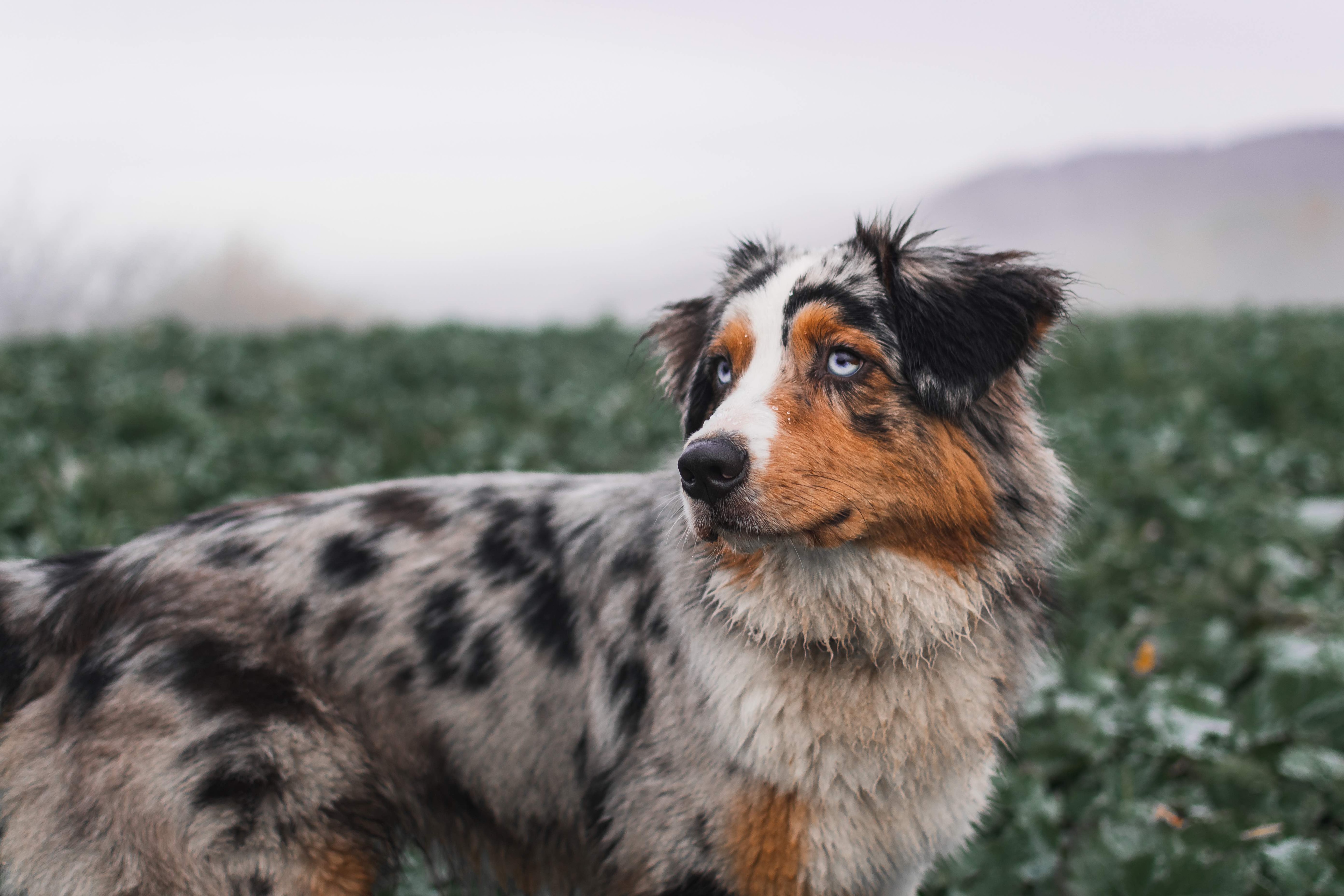
Hip and Elbow Dysplasia
Hip dysplasia and elbow dysplasia are inherited conditions that sometimes affect Australian Shepherds.
These conditions occur when either the hip or elbow joints develop improperly, resulting in malalignment. This can cause osteoarthritis and pain. It’s very important that breeders obtain certified screening for these genetic conditions prior to breeding any Australian Shepherd to reduce the risk of passing these conditions on to their puppies.
When purchasing an Australian Shepherd puppy, check to ensure the proper Orthopedic Foundation for Animals (OFA) screening or that a PennHIP screening has been performed on the puppy’s parents. If you have adopted an Australian Shepherd or are not able to obtain any parent documentation, you can still get your dog screened for hip and elbow dysplasia to know their risk as they grow.
Dogs with hip or elbow dysplasia need special care as they age; the amount of care will depend on the severity of the dysplasia. Management options include medications, joint supplements, and therapies. There are also surgical treatment options that can help improve mobility.
Progressive Retinal Atrophy
Progressive retinal atrophy (PRA) is a term used for a group of eye diseases. These degenerative diseases affect the photoreceptors in a dog’s retina, which are are responsible for helping dogs see better in low light, detect movement, and detect color. As the cells deteriorate (atrophy) over time, a dog’s vision will deteriorate as well—eventually resulting in incurable blindness.
PRA can present itself in dogs between 3–9 years old. There is also an early onset form of PRA that can affect Australian Shepherd puppies within their first few months of life.
PRA is an inherited condition, so dogs that have been diagnosed should not be bred.
Though it’s not a painful condition for dogs, there is no current effective treatment or cure for PRA. The first signs of PRA are typically night blindness and increased clumsiness (walking/bumping into things). However, because dogs rely heavily on other other senses as well, they can live long, happy lives without vision.
Hereditary Cataracts
Hereditary cataracts can also occur in Australian Shepherds and can be passed on from parents to their puppies. Hereditary cataracts most commonly occur in dogs between 1–5 years old.
A cataract is the “clouding” of the lens of a dog’s eye. This clouding prevents the passage of light and images directly to the retina, which reduces a dog’s vision.
Cataracts can progress over time and ultimately lead to blindness or glaucoma. Currently, the only approved treatment option for cataracts is surgery. Your veterinarian can recommend a board-certified veterinary ophthalmologist to determine if cataract surgery is appropriate.
As generally healthy dogs, the average Australian Shepherd lifespan is 12–15 years. However, they are predisposed to a few health issues more common to the breed.
Iris Coloboma
Iris coloboma is another ocular condition that more commonly affects Australian Shepherds. This condition occurs when the iris (the colored part of the eye that surrounds the pupil) fails to develop properly.
The result can be either:
-
The iris is too small (causing no major issues)
-
The iris is too big (causing light sensitivity or discomfort)
While the light sensitivity and discomfort will not affect quality of life, these will need to be considered when determining the best lifestyle for your dog. In some cases, dog goggles can be used to act as sunglasses and reduce the impact of light sensitivity. But to prevent further eye complications, it’s recommended that severely affected dogs are kept out of bright and direct sunlight.
This is an inherited condition, so breeding pairs should be certified to have normal eyes by a board-certified veterinary ophthalmologist, with the results recorded through the Canine Eye Registry Foundation (CERF) within the previous year. There is no treatment available.
Australian Shepherd puppies should have their eyes examined by a veterinary ophthalmologist after 6 weeks of age.
Epilepsy
Primary epilepsy, a seizure disorder caused by an abnormal electrical disturbance in the brain, is another inherited condition seen in Australian Shepherds.
Unfortunately, there is no genetic testing available to identify which dogs may carry genes associated with epilepsy. Depending on the frequency of the seizures, dogs with this condition may require lifelong daily anti-seizure medications to control their symptoms.
Multidrug Resistance Mutation (MDR1)
Multidrug resistance is a genetic mutation most commonly found in herding breeds, including Australian Shepherds.
When dogs have this condition, it can affect how their body processes certain drugs and medications. The MDR1 gene makes dogs more sensitive to certain ingredients found in commonly used medications for flea and tick prevention, heartworm prevention, diarrhea, and certain cancers. The result is that dogs with the MDR1 gene experience more significant side effects to these medicines at doses that would normally be tolerated by dogs of similar size.
The MDR1 gene can be detected with a DNA test. Talk with your veterinarian about testing and DNA test options. They will also be able to provide guidance on alternative medication options that will not lead to drug-related toxicity.
Deafness
Certain genes that control the coat color of an Australian Shepherd can affect their hearing. Dogs who have two merle-colored parents (there are red and blue merle Australian Shepherds) and have inherited double-merle genes are more likely to be whiter in color. This lack of pigment can affect their hearing as well, especially if there is a lot of white color on the head or ears.
A BAER (Brainstem Auditory Evoked Response) test can be performed to determine if deafness is present.
Lymphosarcoma
Lymphosarcoma is a cancer seen slightly more commonly in Australian Shepherds. This disease occurs when the body forms abnormal lymphocytes, a type of white blood cell. It often presents as swollen lymph nodes, but these abnormal cells can develop in any organ in the body.
Thankfully, it’s one of the most treatable forms of cancer in veterinary patients, with a good success rate in dogs receiving chemotherapy.
Hemangiosarcoma
Hemangiosarcoma is a devastating cancer that has an increased incidence in Australian Shepherds. It most commonly presents as a bleeding tumor within the abdomen, typically affecting the spleen and/or liver. It can lead to:
-
Acute lethargy
-
Weakness
-
Collapse
-
Pale gums
Typically, surgery is required to control the internal bleeding and for definitive diagnosis of the type of tumor.
Unfortunately, even with chemotherapy the prognosis is very poor, with average survival time of six to nine months with both surgery and chemotherapy.
Find a CarePlus insurance plan to match your pet's needs
Learn about CarePlus, insurance plans with exclusive Chewy benefits
What To Feed an Australian Shepherd
Australian Shepherds should be fed a high-quality diet approved by the Association of American Feed Control Officials (AAFCO). Fresh water should be available at all times.
Australian Shepherds with a working job (search and rescue, herding on a farm, or guide dogs) or high activity level (field training, flyball, run several miles a day, hike frequently) may require a higher protein/higher fat diet to meet their needs. Diets labeled as “performance” or “sport” should be considered under the guidance of a veterinarian.
How To Feed an Australian Shepherd
Australian Shepherds can be fed normally with a standard pet food bowl. Meal feeding helps to monitor appetite as well as control intake; this is preferred over filling the bowl and allowing your dog to graze.
Some Australian Shepherds that are highly food motivated may be prone to eating too fast. For these dogs, it’s worth considering a slow feeder bowl to help them slow down and prevent gastrointestinal upset.
How Much To Feed an Australian Shepherd
How much you feed an Australian Shepherd depends on their life stage, body condition score, activity level, and the brand/type of food you’re feeding.
Growing Australian Shepherd puppies should be fed a standard puppy food until they are spayed/neutered or reach maturity, at approximately 12–16 months old. Feed your pup three or four meals a day on a consistent schedule.
Once they reach their full, adult size, Aussies should be slowly transitioned to a high-quality adult diet or performance diet if they have excessively high energy demands—such as working dogs or dogs that accompany pet parents on lengthy fitness routines like running and hiking.
Despite their high energy levels, some Australian Shepherds can be prone to gaining weight as they age, so frequent reevaluation of their dietary needs is important. Your veterinarian will also want to have them tested for conditions that may promote weight gain, such as hypothyroidism or Cushing’s disease.
Nutritional Tips for an Australian Shepherd
Australian Shepherds tend to be very active dogs and can develop osteoarthritis as they age. Your vet may recommend joint supplements as your dog ages.
Australian Shepherds also are predisposed to certain eye conditions, so supplements targeting eye health may also be beneficial. Never give your dog supplements without speaking with your vet first.
Behavior and Training Tips for an Australian Shepherd
Australian Shepherd Personality and Temperament
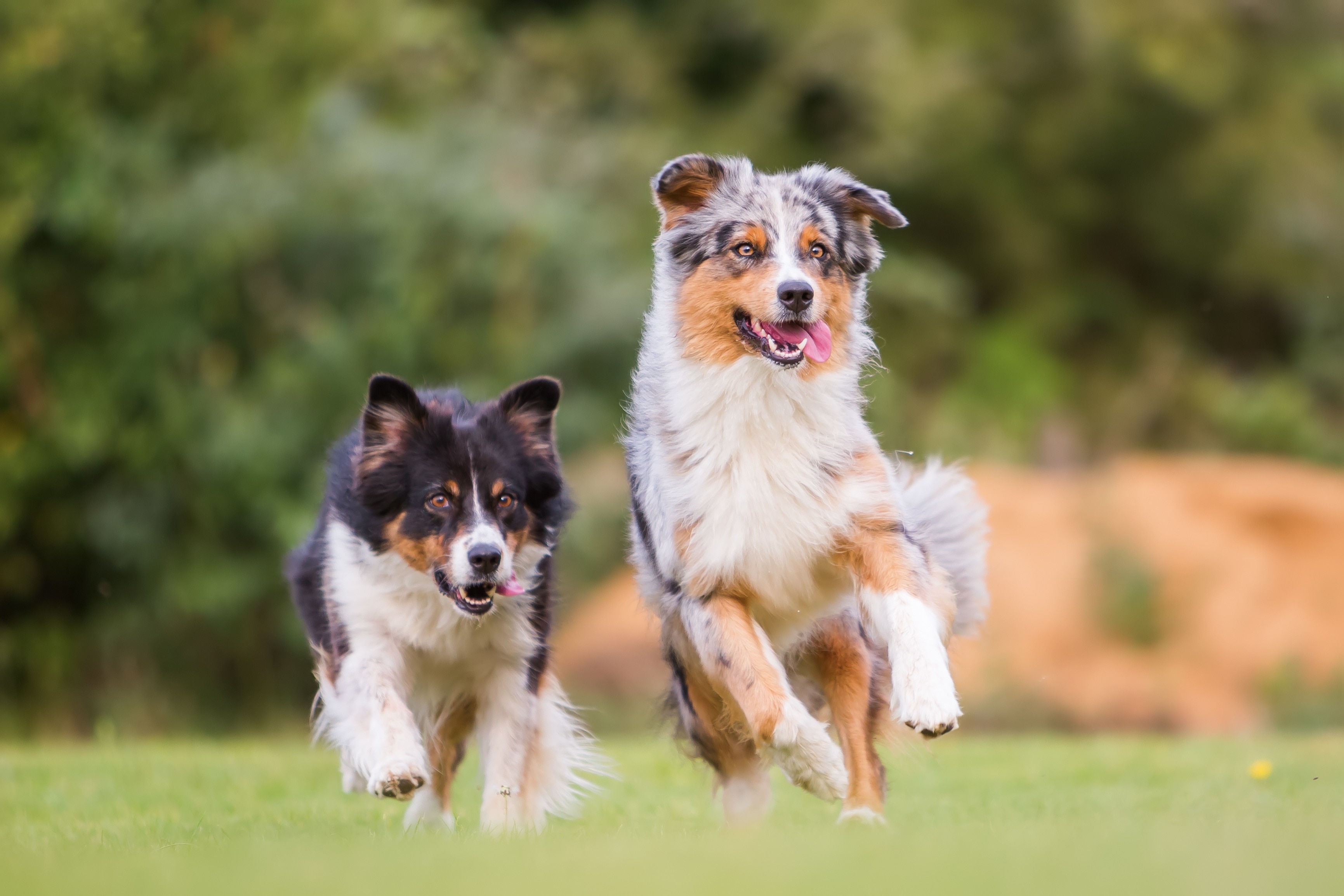
Australian Shepherds are loyal, intelligent dogs with a strong character. Many Aussies are quite friendly, but some can be reserved toward new people. But with a proper introduction, they will often warm up and be accepting.
As with all dog breeds, early socialization is very important. Australian Shepherds can be good with children, cats, and other dogs as long as they are well socialized. But know that their innate herding tendencies may still result in their attempting to herd other small animals and children if this behavior is not redirected.
Australian Shepherds are high-energy dogs that love to have a job. They are known to be smart and loyal dogs that are typically friendly but can sometimes take a bit of time to warm up to strangers.
Australian Shepherds are highly energetic and maintain their energy levels through their adult life and sometimes into their senior years. As a result, consistent exercise and mental stimulation is a must for this breed. Without an outlet for their energy, the Australian Shepherd may develop destructive behaviors, such as digging and chewing.
Australian Shepherd Behavior
With proper training, good socialization, and regular exercise, Australian Shepherds can be very well-behaved dogs. They are also very loyal and attentive to their family, so it’s not uncommon for them to become a shadow and follow their pet parents around as much as possible.
In some cases, this attachment to their favorite humans can develop into separation anxiety. Be sure to work with a trainer and develop healthy attachment styles.
Australian Shepherds are athletic and agile. Without thorough and proper recall training, this breed should be kept on a leash or confined to a secure, fenced yard. They are master escape artists if left unattended and are apt to chase neighborhood squirrels or (worse!) cars.
Australian Shepherd Training
Australian Shepherds are very intelligent and motivated dogs that respond to training readily. Always use positive reinforcement when training.
High-level exercise and long-distance running/hiking sessions should be avoided until your Australian Shepherd puppy is fully grown, which typically occurs between 12–16 months. This helps ensure they don’t hurt their joints, hips, and elbows during their growth years, which could lead to long-term mobility issues.
Fun Activities for Australian Shepherds
-
Field trials
-
Herding trials
-
Flyball
-
Advanced obedience training
-
Hiking
-
Fetch
Australian Shepherd Grooming Guide
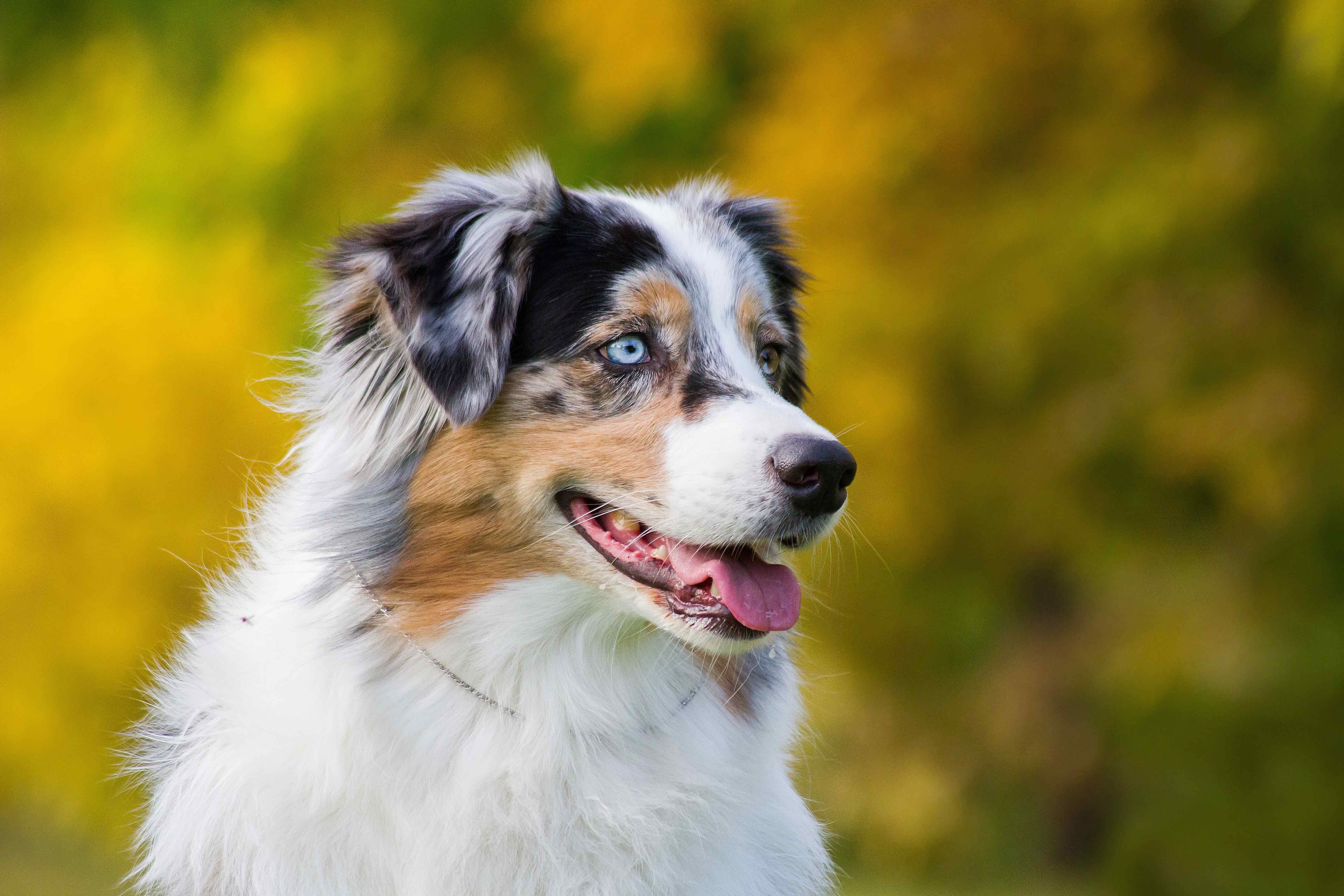
Aussies have a double-layer water-resistant coat. There are many different Australian Shepherd colors and patterns, including red merle, blue merle, red, and black. Their eyes are typically brown or blue.
Because their coat is medium in length, Aussies require routine upkeep and weekly care. Their active, outdoor lifestyle will also mean they need more frequent grooming.
Skin Care
Weekly brushing sessions will help keep your Aussie’s coat looking its best and free of mats. Tangled, matted fur can result in inflammation and skin infections.
Coat Care
Due to their active nature, Australian Shepherds are often outdoors in the mud and dirt. This means frequent bathing will often be part of your grooming routine. Frequent brushing can help minimize shedding.
It’s not recommended to shave an Australian Shepherd’s hair, as their double coat helps to protect them from both heat and cold by holding a layer of temperate air close to their body.
Eye Care
Because Australian Shepherds are predisposed to certain eye issues, routinely checking them and monitoring for excessive discharge or any changes in appearance is a good habit to get into. Talk to your vet if you notice anything different about your pup’s eyes.
Ear Care
With the increased need for bathing and longer hair, clean and check your Australian Shepherd’s ears routinely.
By cleaning their ears, you can prevent infections or the buildup of dirt or debris. These cleanings also ensure that you fully dry your dog’s ears after each grooming session to prevent moisture buildup, which can lead to ear infections.
Nail Care
Trim your dog's nails regularly to prevent overgrowth. If you can hear them clacking on hard surfaces, it's time for a trim.
Dental Care
Brush your Aussie's teeth every day to prevent dental disease in your dog, which can lead to tooth decay, tooth loss, and even damage to other organs. Giving your dog dental chews can help protect their teeth, but it's no substitute for regular brushing.
Always brush your dog's teeth with a dog-friendly toothpaste—never human toothpaste.
Considerations for Pet Parents
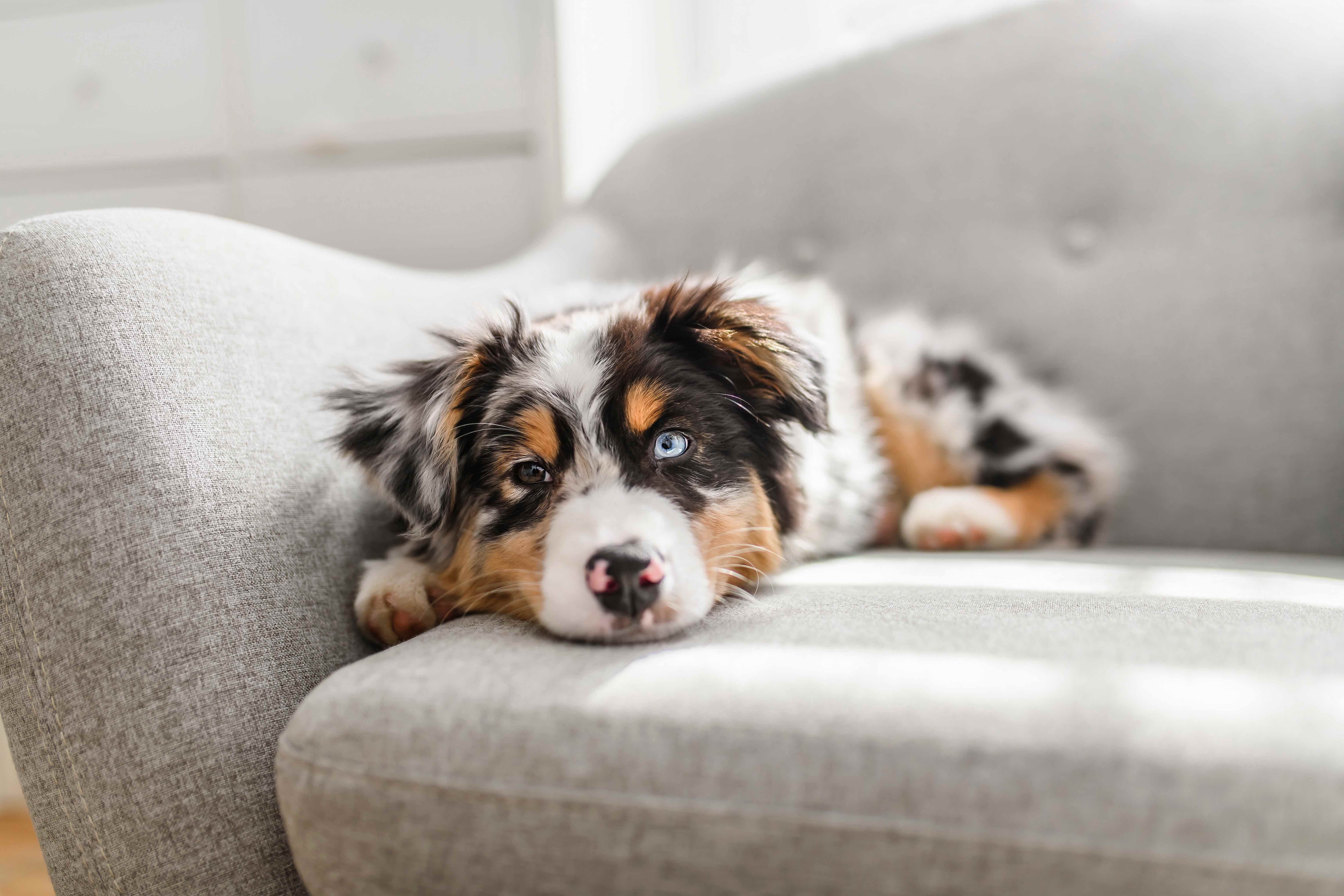
Australian Shepherds are highly energetic dogs that never slow down. This means they require daily devoted exercise for physical and mental stimulation their whole life. Pet parents must be committed to providing Australian Shepherds with the time and attention they require; otherwise, their undirected energy can make them more likely to exhibit destructive behaviors.
Training and socialization is a vital part of the Australian Shepherd’s development and mental growth. Australian Shepherds also thrive with advanced training exercises and fun dog sports, so be ready to invest heavily in their training—both with your time and finances.
Australian Shepherd FAQs
How long do Australian Shepherds live?
The average Australian Shepherd lifespan is 12–15 years.
Do Australian Shepherds shed?
Australian Shepherds shed throughout the year, though they shed heavily in the spring and fall.
How big do Australian Shepherds get?
Australian Shepherds are medium-sized dogs, standing 18–24 inches tall and weighing between 40 and 65 pounds.
There are also Miniature American Shepherds, a breed that looks like mini Australian Shepherds. These dogs don’t grow larger than 18 inches tall and weigh 20–40 pounds.
What’s the difference between a Border Collie vs. an Australian Shepherd?
Border Collies and Australian Shepherds are both high-energy herding dogs with similar appearances. But Border Collies tend to be leaner than Aussies (at 30–55 pounds). Border Collies were also bred in Scotland, while Australian Shepherds originated in the U.S.
Is an Australian Shepherd a good family dog?
Australian Shepherds can make excellent family dogs. However, it’s important to ensure they are well socialized with children so they don’t try to herd them.
Are Australian Shepherds smart dogs?
Australian Shepherds are highly intelligent and very receptive to training and mastering tasks/skills quickly. But this also means they are great escape artists and excellent at finding outlets for mental stimulation (no matter how destructive) if not provided constructive ones.
How much do Australian Shepherds cost?
Cost can vary depending on the breeder, location, lineage, and color markings. The average Australian Shepherd price typically ranges between $500–$2,000.
